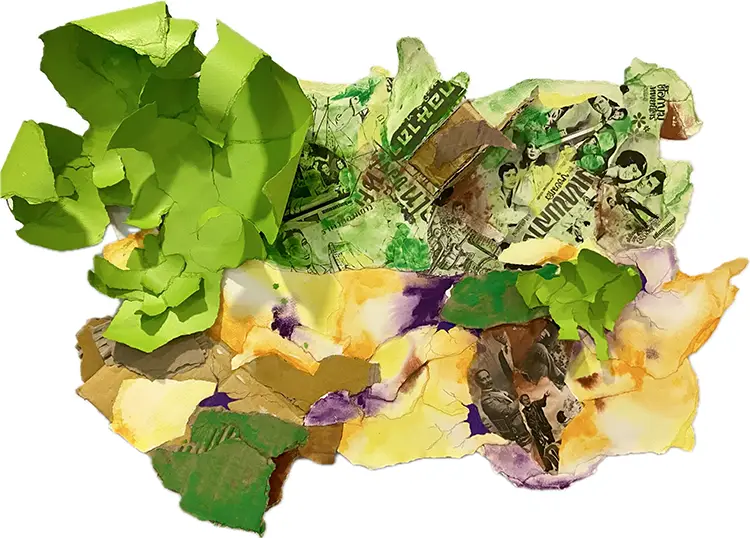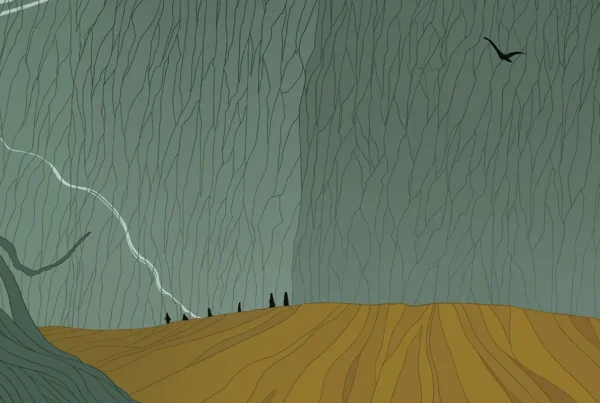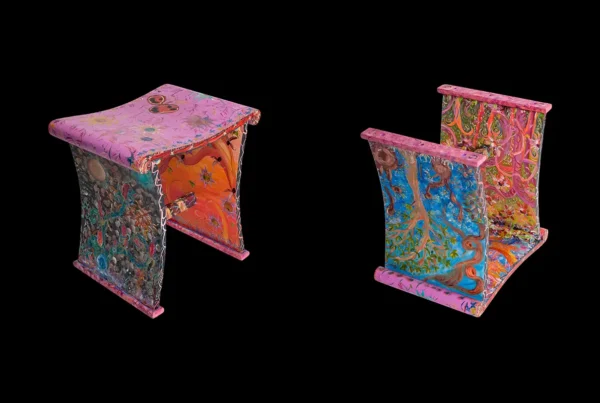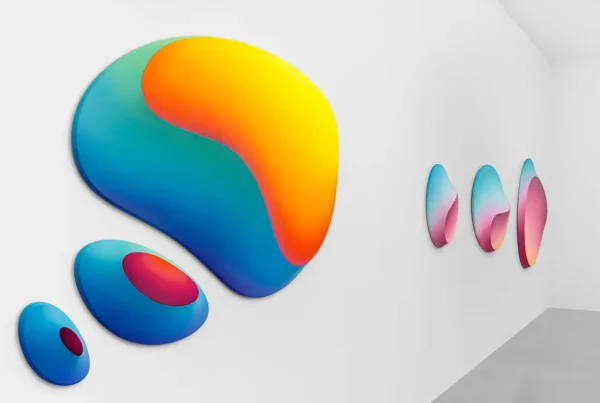“Sometimes dark events can lead to beautiful and creative outcomes.”
Trauma, Art, and the Language of Survival
Jameel Haiat‘s journey as an artist is etched with contradiction, transformation, and resilience. Born in Los Angeles and now residing in Chiang Mai, Thailand, Haiat channels a complex childhood into emotionally charged abstract work that defies categorization. His early life was shaped by cycles of pain and fleeting tenderness—an upbringing filled with emotional ambiguity and physical trauma. The paradox of being punished and then pacified, particularly by both parents, laid a foundation for his creative voice. Rather than suppressing those memories, he confronts them through his art, embedding every torn paper edge and hammered nail with the emotional weight of those formative years. His visual language speaks of conflict and reconciliation, creating works that do not merely aestheticize suffering but translate it into something raw, honest, and powerfully human.
This tension—between destruction and restoration—is central to Haiat’s method and message. His process of ripping materials apart and then rebuilding them into new compositions becomes an act of healing, symbolic of the fragmented nature of memory and the reconstructive power of creativity. Art, for Haiat, is not a passive reflection of life but a means to reclaim agency over his past. His work offers both a reckoning and a release, positioning trauma as both subject and material. The visual intensity of his pieces, often structured from distressed materials like cardboard and watercolor paper, invites the viewer to confront the beauty that can emerge from brokenness. These are not just abstract works; they are emotional architectures built on the debris of lived experience.
Now working from a studio surrounded by the natural calm of northern Thailand’s rice fields and mountains, Haiat has cultivated a space that nurtures focus and meditative engagement. Stripped of digital distractions and equipped with only the essential tools—paper, cardboard, glue, spray paint, and watercolor inks—his studio practice embraces simplicity as a source of innovation. The quiet of his environment contrasts with the emotional turbulence within his work, allowing him to enter a flow state where trauma transforms into creative energy. The physicality of his process, from tearing to assembling, functions as a ritual of reconstruction—each action grounding him more deeply in his truth and artistic purpose.
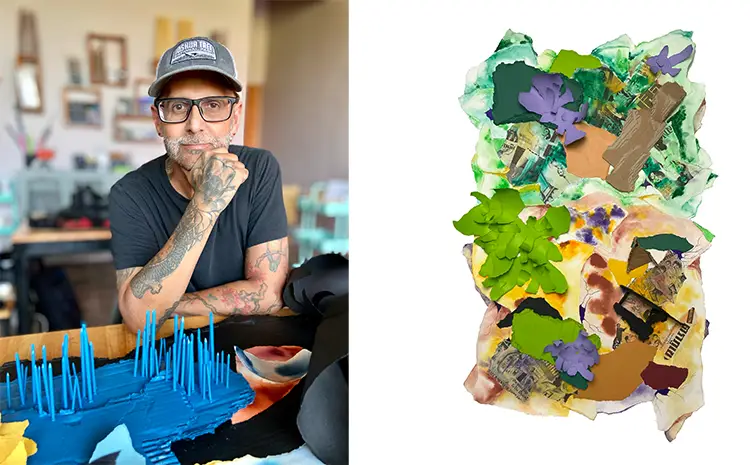
Jameel Haiat: A Voice Freed from the Commercial Cage
Creativity has always been an undercurrent in Jameel Haiat’s life, though it wasn’t until later that he gave it full expression beyond conventional frameworks. He identifies artistic expression as a natural instinct, an intrinsic part of his identity. However, for many years, he deferred to the societal pressures that favored practicality over passion. Initially pursuing a more conventional educational and career path, he entered university guided by external expectations rather than internal conviction. Yet the urge to create was persistent. This tension ultimately propelled him into a career in the Themed Entertainment Industry, where he worked for 25 years as an Art Director and Production Designer. While this field offered an outlet for his creativity, it was still bound by commercial constraints and client directives.
Only recently did Haiat fully liberate himself from those limitations, choosing to follow a less predictable but more fulfilling path. Leaving behind the structured world of commercial art, he embraced a practice that was not driven by briefs or deadlines, but by introspection and emotional authenticity. The shift marked a profound transition—not just in profession but in identity. This newfound freedom allowed him to create from a place of deep personal resonance, unfiltered by the needs of a marketplace. The decision to walk away from a stable career to pursue a raw, emotionally vulnerable form of artistic expression was not without risk, but it was essential to achieving a sense of artistic and personal integrity.
This return to instinct over instruction unlocked new layers in Haiat’s creative process. No longer confined by project scope or external vision, he began to explore form and material in deeply personal ways. The discovery of his current medium—torn paper and cardboard—was serendipitous but transformative. What began as a simple aesthetic experiment with tearing paper evolved into a foundational method of expression. Each layer, each texture, spoke more clearly to his experiences than any previous medium. From painting with oils to sculpting with found materials, Haiat had tried it all, but it was through this seemingly accidental discovery that he found his truest visual vocabulary—one that bridges destruction and beauty with remarkable nuance.
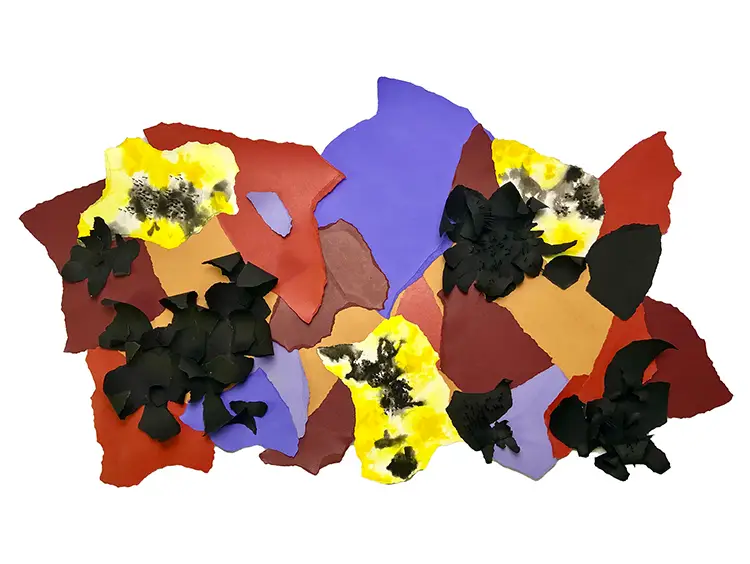
Dimensional Language: Between Flower and Bullet
Haiat’s work resists easy classification, existing at the intersection of abstraction, sculpture, and collage. His compositions stretch beyond flat surfaces, occupying physical space with materials that bear the scars of manipulation—torn, folded, punctured. This dimensionality is not just aesthetic; it is deeply conceptual. His art confronts themes of trauma and healing by embodying them in physical form. Violent imagery—such as the suggestion of bullets or bomb fragments—coexists with the softness of floral elements, creating a visual dialogue between aggression and grace. These juxtapositions compel the viewer to navigate the dualities that define human experience: harm and hope, collapse and recovery.
The use of nails, paper tears, and sculptural mounds is not incidental but symbolic. These recurring forms reflect emotional ruptures and the physical process of healing. The layering of materials creates depth both visually and metaphorically, with each addition functioning like a step in emotional repair. It’s no accident that Haiat’s choice of materials—cardboard and paper—are often seen as disposable or fragile. In his hands, they become durable metaphors for endurance and transformation. He elevates the mundane into monuments of survival, offering a space for viewers to witness the quiet power of persistence and self-reclamation.
Among his many works, the sculpture “Ovoo” stands as a deeply personal testament to this philosophy. Named after the shamanistic stone mounds of Mongolia, traditionally assembled to offer protection and luck on life’s journey, Haiat’s version reinterprets the form using torn cardboard and materials linked to his recovery from throat cancer. Central to the piece are empty containers of plant-based protein powder—his primary source of nutrition due to his reliance on a gastric tube. This sculpture speaks volumes about fragility and resilience, merging the spiritual with the bodily in a raw yet affirming visual narrative. “Ovoo” is not only a reflection of his physical journey through illness, but a symbol of his ongoing fight to find light in the darkest spaces.
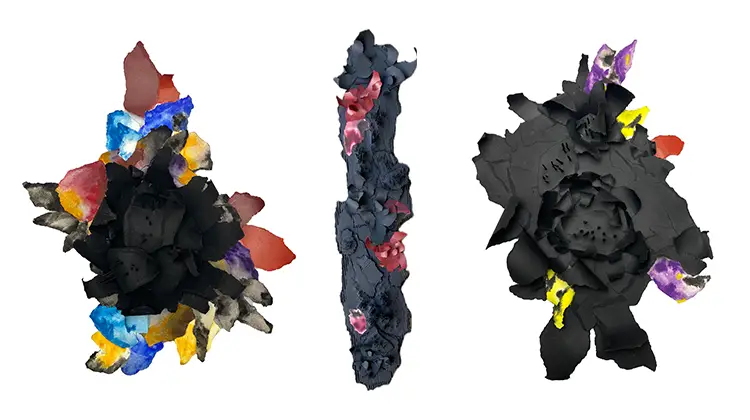
Jameel Haiat: The Future Built from Scraps
In the heart of Chiang Mai, where mountains rise and forests stretch across the horizon, Jameel Haiat finds clarity—not just in the landscape, but in his vision for the future. His studio, nestled amid this natural abundance, becomes both sanctuary and laboratory. Here, Haiat dreams of pushing his practice into uncharted territory by developing large-scale, immersive installations that allow viewers to physically enter his artistic universe. He envisions environments constructed from his signature materials—torn cardboard, layered paper, protruding nails—expanding into spaces that can be walked through, touched, and emotionally experienced. These immersive structures would invite audiences to move through trauma, just as he does with each piece, experiencing art not as something to observe, but to inhabit.
This ambition stems from Haiat’s profound desire to connect—not simply to display—but to facilitate emotional resonance. He believes that giving people the opportunity to interact with his work on a physical level will deepen their engagement and enhance the psychological impact. The installation would not be passive or ornamental, but visceral. Just as his materials reflect his journey from rupture to restoration, the audience too would be invited to travel through those metaphors—turning the gallery into a shared space of reflection, confrontation, and healing. It’s a concept that speaks not only to artistic innovation but to the fundamental human need for connection and transformation.
While his influences are as varied as they are legendary—Louise Nevelson, Ai Wei Wei, Yayoi Kusama, Jackson Pollock, Jean-Michel Basquiat, Andy Warhol, and Cornelia Parker—Haiat’s voice remains distinctly his own. Nevelson, with her monochrome, dimensional works crafted from found objects, left a particularly lasting impression, setting an early template for how materiality could carry meaning. Yet Haiat has evolved these inspirations into something deeply personal. His art is not about homage, but about building a language uniquely capable of expressing his life’s complexities. In every ripped fragment and sculpted ridge, he tells a story not only of what was endured, but of what can be rebuilt.
